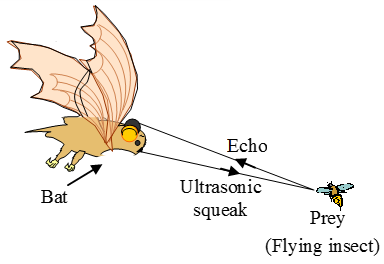What Is Ultrasound
The sound waves having frequency higher than 20,000 Hz is called ultrasonic waves or ultrasound. Human beings cannot hear ultrasound. Dogs, bats and dolphins can hear ultrasound.
For example bats and dolphins can hear sound waves having frequencies of about 150,000 Hz. Bats and dolphins detect the presence of any obstacle by hearing the echo of the sound produced by them.
Ultrasound finds many technological applications.
Audible Wave: The human ear is sensitive to sound waves of frequency between 20 Hz to 20 kHz. This range is known as audible range and these waves are known as audible waves.
Example: Waves produced by vibrating sitar, guitar, organ pipes, flutes, shehnai etc.
Ultrasonic waves: A longitudinal wave whose frequency is above the upper limit of audible range i.e. 20 kHz, is called ultrasonic wave. It is generated by very small sources.
Example: Quartz crystal
Infrasonic wave: A longitudinal elastic wave whose frequency is below the audible range i.e. 20 Hz, is called an infrasonic wave. It is generally generated by a large source.
Example: Earthquake.
Characteristics of Ultra Sound
Ultrasound (or ultrasonic waves) are found very useful due to the following reasons:
- Ultrasound (or ultrasonic) waves are high frequency sound waves. So these waves have short wavelength. These short wavelength sound waves can be reflected back from the smaller objects. Thus, ultrasound can detect smaller objects (< 1 cm size). The sound waves in the audible range cannot detect or ‘see’ objects smaller than having size ranging from a few tens of centimeters to a few metres.
- Ultrasound beam is more directional and can be aimed towards any target just like a torch. These waves remain undeviated over long distances.
Applications of Ultrasound
Some important applications of ultrasound are described below :
- In ultrasonic spectacles for blind people: Such a spectacle is fitted with a transmitter and a receiver. The receiver produces a high or low sound in the person’s ear depending upon whether the object causing the echo is near or far.
- For medical use: Ultrasound is used to detect any infirmity / deformity in the unborn baby (X-rays cannot be used for this purpose because X-rays may harm the unborn baby). In this method, an ultrasonic transmitter / receiver is moved across the mother’s stomach. Different tissues (skin, muscles, bones) reflect the sound waves differently to produce many echoes. The machine uses these echoes to construct a picture on the screen. Any deformity / infirmity in the baby can be detected and proper treatment could be prescribed.
This technology has been misused for knowing the sex of the unborn baby. It has been noticed that many people force the would-be mother to have an abortion if the unborn baby is identified to be a female baby. This practice is unethical and a social crime. Our Government has banned such practices. We all should work together to eradicate this social menace. - In echocardiography: In this medical diagnostic technique, ultrasonic waves are used to construct the image of the heart.
- For determining the depth of sea: Ships use ultrasound to determine the depth of the sea by echo-sounding method. A transmitter on the ship sends ultrasound towards the sea-bed and the receiver receives the echo. From the time gap between the two signals, the depth of the sea can be estimated. This is illustrated below.
- For clearing hard to reach places: Ultrasonic waves are also used for clearing hard to reach places, such as spiral tube, odd shaped machine parts / components, electronic components etc. The object to be cleaned is kept in the ‘cleaning solution’ and the solution is subjected to the ultrasonic waves. The high frequency (ultrasonic) waves stir up the dust / dirt particles. These particles get detached and the object is thoroughly cleaned.
- Bats fly in the darkness of night without colliding with other objects by the method of echolocation. Bats emit high frequency ultrasonic squeaks while flying and listen to the echoes produced by the reflection of their squeaks from the objects in their path. From the time taken by the echo to be heard, bats can judge the distance of the objects in their path and hence avoid it by changing the direction. Bats search their prey at night by the method of echolocation.

